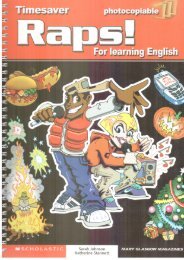English_Book_2-Teacher_300913
English_Book_2-Teacher_300913
English_Book_2-Teacher_300913
You also want an ePaper? Increase the reach of your titles
YUMPU automatically turns print PDFs into web optimized ePapers that Google loves.
15 Reading (5 min.)• Have students scan the IM conversation. Ask Whois having the conversation? (Liza and Annie) Who arethey talking about? (Brian and Joey)• Read the instructions and elicit or explain themeaning of acronym (the combination of thefirst letters of words). Elicit or give examples ofacronyms in the students’ L1 as well as <strong>English</strong>acronyms they have already learned; for example,CD for compact disc and IM for instant message.• Call on two students to read the roles aloud.Explain the expressions for hours (for a longtime), That’s so random (That doesn’t make sense),Speaking of . . . (used when someone wants tochange the subject because he or she has just beenreminded of something), bump into (meet someoneby accident), and relax.• Elicit the meanings of the acronyms.Answer keyB4N = Bye for now.TTYL = Talk to you later.16 Comprehension (5 min. or less)• PAIRS. Draw the emoticons and on theboard. Elicit what feelings each can stand for:good feelings like happy, pleased, and excited for thesmiley face, and bad feelings like sad and sorry forthe frownie face. Explain or elicit the meaning ofemoticon. (a typed icon or symbol that stands for aparticular feeling)• Have students work in pairs to draw an emoticonfor each sentence. Check by having volunteers saywhich emoticon they chose and why.17 Vocabulary (5 min.)A.• Read the instructions, then go over the emotionsvocabulary. As the class reads each word, quicklyact out or show the emotion or action on your face.• Have students match the emoticons with theemotions. Check answers orally by askingquestions such as What’s the emotion foremoticon 2?Answer key1. d2. a3. e4. g5. b6. c7. fB.• Read the instructions and elicit the meaning ofacronym. Explain the meaning of Got to go, As soonas possible, and Be right back. Elicit the answers tothe first two items.• Have students work independently to match theacronyms with the expressions. Check answersorally, explaining as necessary.Answer key1. e2. f3. g4. a5. d6. b7. cTEACHER’S NOTESAnswer key1.2.3.4.Have students complete Workbook Exercise 3.18 Your turn (10 min.)• GROUPS. In groups of four, have students puttogether a list of emoticons and acronyms theyusually use to communicate with each other. Havethem include their meanings in the list.• Ask each group to present their list to the class.Make a class list of the most common emoticonsand acronyms on the board.T48:51:36 PMPostcards_splitB_TE1_U05.indd T482/27/07 10:21:20 AM




